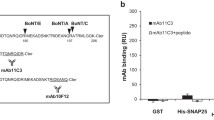Abstract
The production of botulinum neurotoxin A (BoNT/A) for therapeutic and cosmetic applications requires precise determination of batch potency, and the enzymatic activity of BoNT/A light chain is a crucial index that can be measured in vitro. We previously established a SNAP-25 chip-based assay using surface plasmon resonance (SPR) that is more sensitive than the standard mouse bioassay for the quantification of BoNT/A activity. We have now adapted this procedure for pharmaceutical preparations. The optimized SPR assay allowed multiple measurements on a single chip, including the kinetics of substrate cleavage. The activity of five different batches of a pharmaceutical BoNT/A preparation was determined in a blind study by SPR and found to be in agreement with data from the in vivo mouse lethality assay. Biosensor detection of specific proteolytic products has the potential to accurately monitor the activity of pharmaceutical BoNT/A preparations, and a single chip can be used to assay more than 100 samples.





Similar content being viewed by others
References
Adler S, Bicker G, Bigalke H, Bishop C, Blumel J, Dressler D, Fitzgerald J, Gessler F, Heuschen H, Kegel B, Luch A, Milne C, Pickett A, Ratsch H, Ruhdel I, Sesardic D, Stephens M, Stiens G, Thornton PD, Thurmer R, Vey M, Spielmann H, Grune B, Liebsch M (2010) The current scientific and legal status of alternative methods to the LD50 test for botulinum neurotoxin potency testing. The report and recommendations of a ZEBET Expert Meeting. Altern Lab Anim 38(4):315–330
Capek P, Dickerson TJ (2010) Sensing the deadliest toxin: technologies for botulinum neurotoxin detection. Toxins 2(1):24–53
Chen S (2012) Clinical uses of botulinum neurotoxins: current indications, limitations and future developments. Toxins 4(10):913–939
Dhaked RK, Singh MK, Singh P, Gupta P (2010) Botulinum toxin: bioweapon & magic drug. Indian J Med Res 132:489–503
Dressler D (2012) Clinical applications of botulinum toxin. Curr Opin Microbiol 15(3):325–336
Dressler D (2013) Botulinum toxin therapy: its use for neurological disorders of the autonomic nervous system. J Neurol 260(3):701–713
Ekong TA, Feavers IM, Sesardic D (1997) Recombinant SNAP-25 is an effective substrate for Clostridium botulinum type A toxin endopeptidase activity in vitro. Microbiology (Reading, England) 143(Pt 10):3337–3347
Helmerhorst E, Chandler DJ, Nussio M, Mamotte CD (2012) Real-time and label-free bio-sensing of molecular interactions by surface plasmon resonance: a laboratory medicine perspective. Clin Biochem Rev 33(4):161–173
Hunt T, Rupp D, Shimizu G, Tam K, Weidler J, Xie J (2010) Characterization of SNARE cleavage products generated by formulated botulinum neurotoxin type-a drug products. Toxins 2(8):2198–2212
Kohler JM, Henkel T (2005) Chip devices for miniaturized biotechnology. Appl Microbiol Biotechnol 69(2):113–125
Lévêque C, Ferracci G, Maulet Y, Grand-Masson C, Blanchard MP, Seagar M, El Far O (2013) A substrate sensor chip to assay the enzymatic activity of Botulinum neurotoxin A. Biosens Bioelectron 49:276–281
Lévêque C, Ferracci G, Maulet Y, Mazuet C, Popoff M, Seagar M, El Far O (2014) Direct biosensor detection of botulinum neurotoxin endopeptidase activity in sera from patients with type A botulism. Biosens Bioelectron 57:207–212
Pickett A, Perrow K (2010) Formulation composition of botulinum toxins in clinical use. J Drugs Dermatol 9(9):1085–1091
Popoff MR (2014) Botulinum neurotoxins: more and more diverse and fascinating toxic proteins. J Infect Dis 209(2):168–169
Rossetto O, Pirazzini M, Montecucco C (2014) Botulinum neurotoxins: genetic, structural and mechanistic insights. Nat Rev Microbiol 12(8):535–549
Straughan D (2006) Progress in applying the Three Rs to the potency testing of Botulinum toxin type A. Altern Lab Anim 34(3):305–313
Acknowledgments
This work was supported by the INSERM and CNRS. The authors would like to thank IPSEN Biopharm for supplying Dysport samples. We thank Dr. Raymond Miquelis for valuable discussions and advices.
Author information
Authors and Affiliations
Corresponding author
Rights and permissions
About this article
Cite this article
Lévêque, C., Ferracci, G., Maulet, Y. et al. A chip-based assay for botulinum neurotoxin A activity in pharmaceutical preparations. Appl Microbiol Biotechnol 99, 4355–4360 (2015). https://doi.org/10.1007/s00253-015-6438-z
Received:
Accepted:
Published:
Issue Date:
DOI: https://doi.org/10.1007/s00253-015-6438-z




